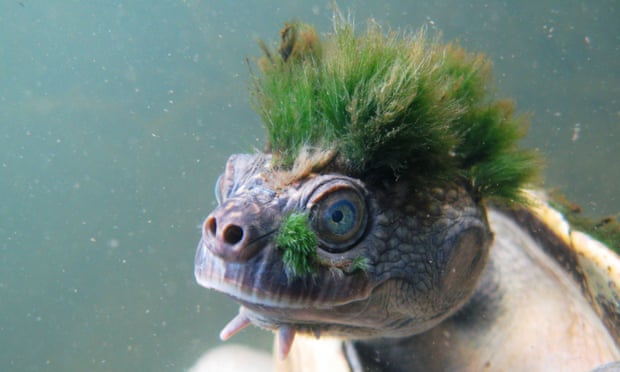It sports a green mohican, fleshy finger-like growths under its chin and can breathe through its genitals.
The Mary river turtle is one of the most striking creatures on the planet, and it is also one of the most endangered.
The 40cm long turtle, which is only found on the Mary river in Queensland, features in a new list of the most vulnerable reptile species compiled by the Zoological Society of London (ZSL).
Despite the turtle’s punk appearance – derived from vertical strands of algae that also grow on its body – its docile nature made it historically popular as a pet.
Gill-like organs within its cloaca – an orifice used by reptiles for excretion and mating – enable it to stay underwater for up to three days, but it was unable to hide from the pet collectors who raided its nests during the 1960s and 1970s.
The turtle is placed at 30th on ZSL’s Evolutionarily Distinct and Globally Endangered (Edge) list for reptiles. First established in 2007, Edge lists have previously been published for amphibians, birds, corals and mammals, helping guide conservation priorities for 100 most at-risk species. Each species is given a score which combines extinction risk with its evolutionary isolation or uniqueness, with the latest list supported by a study in the journal Plos One.
Top of the list is the Madagascar big-headed turtle, which has an Edge score higher than that of any other amphibian, bird or mammal, and is still taken for food and global trade.
Other unusual and endangered species include the Round Island keel-scaled boa from Mauritius, a snake which is the only terrestrial vertebrate known to have a hinged upper jaw; the minute leaf chameleon from Madagascar which is the size of a human thumbnail; and the gharial, a slender-snouted fish-eating freshwater crocodile. Less than 235 gharial survive in the rivers of northern India and Nepal.
Rikki Gumbs, co-ordinator of Edge reptiles, said: “Reptiles often receive the short end of the stick in conservation terms, compared with the likes of birds and mammals. However, the Edge reptiles list highlights just how unique, vulnerable and amazing these creatures really are.”
He added: “Just as with tigers, rhinos and elephants, it is vital we do our utmost to save these unique and too often overlooked animals. Many Edge reptiles are the sole survivors of ancient lineages, whose branches of the tree of life stretch back to the age of the dinosaurs. If we lose these species there will be nothing like them left on Earth.”









